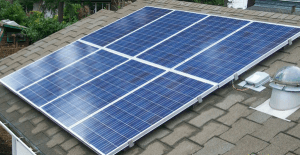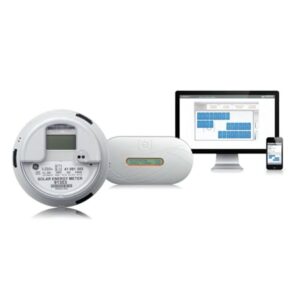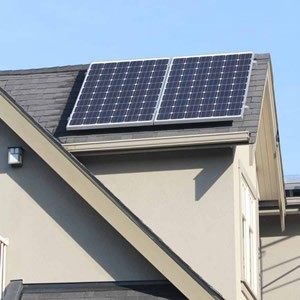It’s October. The weather is changing here in Canada, and with a waning summer sun, it doesn’t really seem like the time to be discussing solar power. But in fact it is the best time to discuss solar and how it can be used to reduce, or even eliminate, your electric utility bill.
Why is October a good month to talk solar? Two reasons…
1. You will want to throw the ‘ON’ switch in early spring
2. You need time to plan
The best time to install a solar power system is in the early spring. Not simply because you are wanting to wait until the sunshine returns, but because you will want an anniversary date that optimizes your financial return on the production of power.
Let’s take it back a step and introduce the concept of…
Net Metering
Net metering is the name given to programs offered by utility companies that enable people to generate their own power & sell it back to the utility.
When you decide to install a solar power system, you will need to get in touch with your electric utility, and complete an application to generate your own power and connect it to the grid (see the list of Canadian utility program links at the bottom of the page). These ‘net metering’ applications vary slightly from province to province, but essentially they want to know what type of system you are installing (solar, wind, hydro), how large it is going to be, and what equipment you plan to use to interact with the grid. The utility then does their due diligence to make sure that your local power poles can handle the connection, that you are using approved equipment, and that the system is designed & will be installed properly. Once you get the green light on your plans, you are free to source the equipment, & do the installation. When completed, the utility inspects, and gives you approval to throw the ‘on’ switch. The date when you finally get to energize your system is very important… this is your commissioning date or anniversary date, and it serves as the reference the utility uses when accounting for the power you generate.
Importance of The Commissioning Date
Why is the commissioning date important?
I’ll use an example to illustrate. Here in BC, the net metering program provided by BC Hydro allows you to carry forward, from month-to-month, any excess power you happen to generate. Any credits you amass in over producing in one period can be used to offset your consumption in the next billing period. This is great, as it allows you to use the power you generate through the summer to offset your electricity consumption during the winter months. BC Hydro invoices residential customers on a 2-tier rate approach: once you exceed a certain threshold of power consumption, your rate jumps to a higher level, and you pay more…
BC Hydro’s 2016 rates…
Rate Step 1:
$0.0829 per kWh for first 1,350 kWh in an average two month billing period
Rate Step 2
$0.1243 per kWh over the 1,350 Step 1 threshold.
So, a nice aspect of generating some of your own power, is that you reduce the amount of power you need to purchase from the utility. This effectively comes off the top of your utility invoice. If you get into the Tier 2 pricing, you are saving 12.43 cents per kWh. Reduce it enough, and you may never have to pay the Tier 2 rates (in BC anyway). Clearly, one of your goals in designing your system should logically be to reduce, or eliminate your consumption at the Tier 2 rate. You would do this by looking at your utility invoice in the worst winter month, see what you consumed at the Tier 2 rate, and then design a solar PV system to meet that number (I can help you do that). But, even if you have a small solar PV system, you will be winning.
Now let’s suppose that you install a system large enough to offset all of your consumption. Here’s where the commissioning, or anniversary date comes into play, and a little bit of strategy is in order. BC Hydro carries forward any credits for power you generate in excess of the power you consume. Should you get to the end of your year (your anniversary date) with credits remaining, BC Hydro will cut you a cheque. Yes, you read that correctly. However, the rate they use to pay you for the credits you have remaining in your account is set at 9.9 cents/kWh. Not as much as Tier 2, but certainly better than Tier 1. It’s not likely to increase though.
Some utilities allow you to carry forward for another year, while others simply say ‘Thanks for the power’, reset your account meter and let remaining credits expire. Knowing all that, and regardless of how your utility accounts for your production credits, you will want to have as few credits remaining at the end of the year as possible. You want to use the power you generate to offset Tier 2 (12.43 cents/kWh in BC) – getting paid at 9.9 cents is not as good!
Therefore, it makes sense to generate power and amass credits through the summer, use those credits up during the winter, and hopefully, if you install a large enough system, get paid for excess production at the end of your year. To do this most advantageously, you will want an anniversary date in the March-May timeframe.
What If You Have A Fall Commissioning Date?
Still good… especially for smaller systems. You will generate power that reduces your most expensive rate electricity. But if you generate more than you consume, it’s not as good.
Example: You flip the switch and start generating power in October. But, since it’s fall & winter, you are only generating enough power to offset some of your consumption. Not bad, since it reduces your highest utility priced power purchase. Spring rolls around, and you start eliminating your highest-price billing, and perhaps even start amassing credits. But, when your anniversary date rolls around, instead of having those credits applied to Tier 2 consumption (12.43 cents), you are paid out at 9.9 cents (in BC). Not as good.
If your utility resets your account & erases any credits, it is really not as good.
Remember, that this only applies to systems large enough to bank credits by generating more than you consume (at least through the summer months).
Where does this leave us?
Plan Now For A Spring Install
My point number 2… you can use the coming 4 months to properly design your system, obtain estimates for the equipment & labour, and sort out any financing that might be needed.
Questions you will want to answer…
- How much solar could I reasonably, & tastefully, install on my roof or property?
Find out what the upper limit is
Find out what aesthetics are available - How much solar is needed to offset the highest pricing rates on my winter utility bills?
Check your past utility invoices to find out how much power you consume - How much would a system cost?
Decide on a couple of performance levels, and get quotes
There are a lot of equipment options, so compare specs & quotes - Can I expand the system in the future?
Some systems can be added to easily – a good option for starting small - Who will do the roof or ground installation?
A roofer can install the roof mountings, or contractor for ground mounts, or yourself
An electrician should be used to install the electrical parts, especially AC power
If you do it all yourself – you will still need an inspection
That should be enough to jumpstart your plans to add solar to your home.
I’ll end this article with some additional resources for you…
- Download our Solar Power Information Package for Homeowners.
- Request your FREE Site Evaluation
Net Metering Links…
- BC
https://www.bchydro.com/energy-in-bc/acquiring_power/current_offerings/net_metering.html?WT.mc_id=rd_netmetering - Alberta
http://www.energy.alberta.ca/electricity/microgen.asp - Saskatchewan
http://www.saskpower.com/efficiency-programs-and-tips/generate-your-own-power/self-generation-programs/net-metering-program/ - Manitoba
https://www.hydro.mb.ca/environment/energy_sources/solar.shtml - Ontario
http://www.hydroone.com/Generators/Pages/NetMetering.aspx
&
http://microfit.powerauthority.on.ca/ - Quebec
http://www.hydroquebec.com/self-generation/faq.html - New Brunswick
https://www.nbpower.com/en/products-services/net-metering/ - Nova Scotia
http://www.nspower.ca/en/home/for-my-home/make-your-own-energy/enhanced-net-metering/default.aspx - PEI
http://www.maritimeelectric.com/environment/env_energy.aspx - Newfoundland/Labrador
http://www.thetelegram.com/Business/2016-05-27/article-4542055/Wait-continues-for-net-metering-in-N.L./1 - Nunavut
http://www.nunavutenergy.ca/Nunavuts_Energy_System - NWT
https://www.ntpc.com/customer-service/net-billing - Yukon
http://www.energy.gov.yk.ca/publications.html

Hello, we intend to install a combination of solar and wind energy capture to offset the carbon footprint of our new build in Union Bay so I wanted to talk to you about some options. Please let me know a good time.
Hi Tom, I believe we have made contact regarding your project via email & phone. Thanks again!